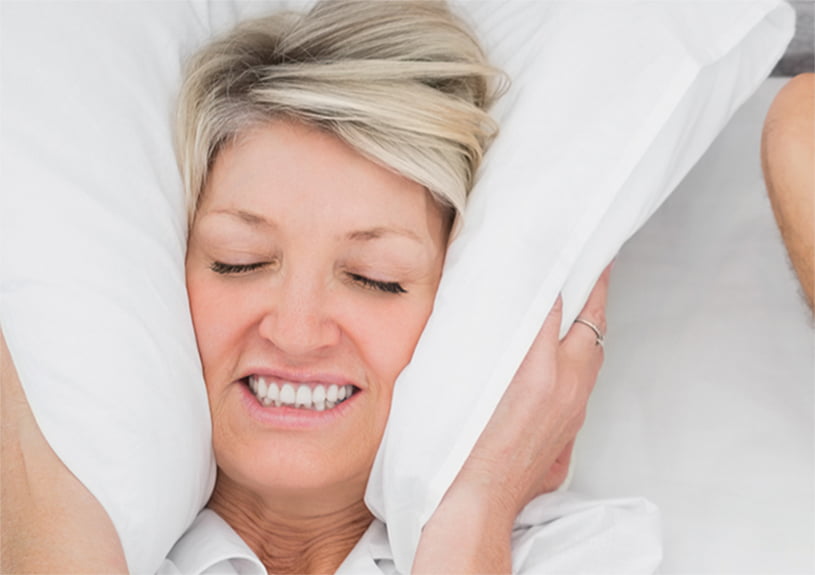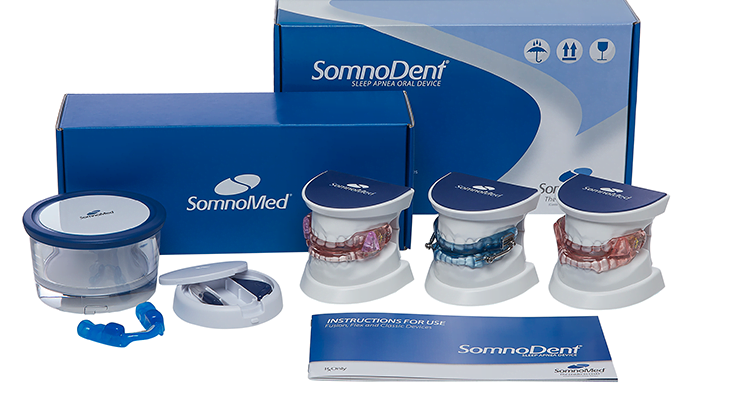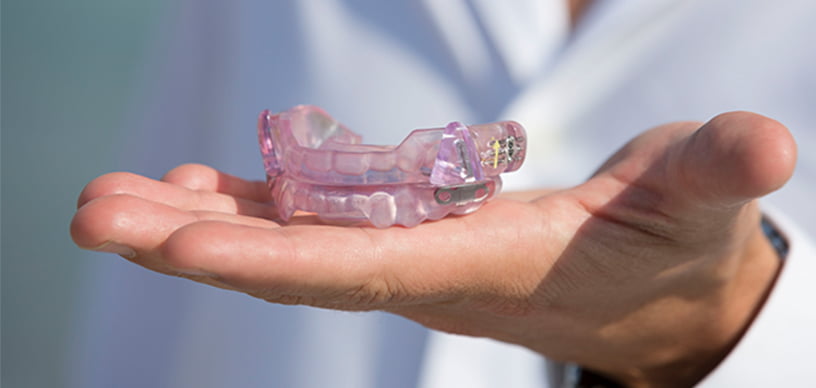What is Obstructive Sleep Apnoea?
Obstructive Sleep apnoea or OSA affects millions of people every year, but since it occurs at night while you sleep, people are unaware they are suffering and therefore goes undiagnosed. Signs and symptoms include unrefreshed sleep, daytime sleepiness, depression, morning headaches and going to the toilet frequently throughout the night. For many, gagging or gasping for air at times whilst sleeping or loud snoring is common.
OSA results from the tongue and soft palate collapsing onto the back of the throat while you sleep. This obstructs the upper airway, causing airflow to be restricted or completely stop.
An apnoeic event lasts for 10 seconds or more at a time. Your brain signals the body that there is a lack of oxygen and adrenalin is released and you arouse, this is where you may gasp for breath. Your airway will open the obstruction in your throat and you will begin breathing again. In patients with OSA this process will repeat itself repeatedly through the night. In some very severe cases people can stop breathing for as much as 40 seconds over 60 times an hour. The combination of low oxygen levels and consistent, disturbed, and interrupted sleep can causes the patient to feel exhausted throughout the day, but in some cases the patient does not even know how bad their sleep really is. It is vital that if you have any symptoms you have a sleep study to assess your risk of sleep disordered breathing; as the ill effects of OSA can contribute to a host of very serious health concerns like cardiovascular disease, stroke and heart attack.
Types of Sleep Apnoea
Obstructive Sleep Apnoea (OSA)
Is the most common sleep related breathing disorder, where the upper airway repeatedly collapses during sleep. During an obstructive breathing event, someone with OSA continues to breathe but cannot get enough air into the lungs because the upper airway becomes too narrow or closes completely, this is known as an obstructive apnoea. The soft tissue in the back of your throat or tongue base collapses and then obstructs your airway resulting in decreased oxygen intake. The brain detects the oxygen deficiency which then leads to multiple momentary arousals to draw breath – profoundly interrupting your deep sleep.
Central Sleep Apnoea
Is another condition where your airway does not become blocked, but instead your brain does not send the signal to your muscles to breathe. In this type we may need to refer you to a specialist.
Mixed Apnoea
Is a combination of both central and obstructive Sleep apnoea. If you have mixed Sleep apnoea you may experience snoring, but you may find that treatments designed to help airway obstructions will not fully stop apnoeic episodes. Though your brain briefly arouses you in order for you to resume breathing, your sleep is constantly interrupted. This leaves you feeling fatigued the next day.
Who’s at risk?
Those that suffer an increased risk of suffering from Sleep Apnoea are males who are moderately to severely overweight, and those over the age of 40. But almost anyone can suffer; even petite women and children. This potentially life threatening disease is a lot more common than generally expected and should be taken very seriously.
What are the signs and symptoms of Sleep Apnoea?
- Tiredness/fatigue and irritability in the mornings and during the day
- Snoring
- Daytime sleepiness
- Depression
- Frequently waking throughout the night to go to the toilet or get a drink
- Regular Morning Headaches
- Worn teeth caused by clenching or grinding of teeth
- Poor memory
- Reflux problems
- Dark circles or bags under or around the eyes

Why is it so harmful?
Repetitive airway collapse can lead to large pressure fluctuations in the lungs and oxygen deficiency which places stress on the heart and cardiovascular system. Consequently in people with OSA, the risk of high blood pressure, stroke and cardiovascular mortality is increased as is diabetes. Therefore it’s imperative that once diagnosed with OSA you are adequately treated.
The strains on a person’s body from arousing over and over due to lack of oxygen, as much as 500 times a night; inhibit them from getting the refreshing sleep they need. Not only is OSA a major, often unrecognized, cause of daytime sleepiness, it can also be an associated risk factor for very serious medical conditions:
- Stroke
- Heart Disease (33% increase in cardiovascular disease)
- High Blood Pressure
- Immune deficiencies
- Headaches
- Depression
- Memory Impairment / loss
- Poor Motor Skills
How do you get diagnosed?
Because Sleep apnoea occurs at night while you should be sleeping deeply, diagnosis isn’t as easy as a quick visit to your local GP.
There are a couple of options where to have a sleep study. The gold standard is the in-lab hospital sleep study where your sleep will need to be monitored by a trained professional who will also use a series of highly specialised instruments to monitor your body through a night’s sleep. But for those patients who struggle to sleep in strange surroundings, there is a range of in home sleep study options.
In the comfort of your own home, the home sleep study monitors you while you sleep in your natural surroundings. You’ll be monitored through the night with specialised sleep therapy equipment in the comfort of your home and bed.
Why should I have a Sleep Study?
It is imperative that you have a sleep study prior to being fitted with any sort of treatment for sleep disordered breathing. Even if you think you just snore, it is possible that you have some level of OSA and may need to see a specialist. Healthcare funds recognise this and will not give any rebate for any treatment of sleep disordered breathing snoring or OSA unless the patient has had a full sleep study which has been analysed by a Sleep Physician.
You will first need to schedule a professional sleep study to properly and legally diagnose your condition as Snoring or Sleep apnoea. You can choose to perform your study in a hospital situation with all the latest technology. But not everyone is suited to undergo a hospital based sleep evaluation and so may elect to schedule an in-home evaluation.
Snoring and Obstructive Sleep Apnoea Treatment Solutions
If you or a loved one snores, the problem can be more than just a social embarrassment. Historically those who were afflicted with the condition were left to live out their restless lives without a treatment solution. There are many non-surgical alternatives to traditional snoring and Sleep apnoea therapies. Sleep disorders, if left untreated, can result in a host of serious negative side effects to your overall health and mental well-being.
Oral Devices
For those who suffer with Mild to Moderate Obstructive Sleep apnoea, or in more Severe cases where CPAP is not tolerated an oral device such SomnoDent may be suitable. SomnoDent is a clinically proven and effective device for treating Obstructive Sleep apnoea and Snoring. This device is worn while you sleep and works to open your airway by bringing the lower jaw and effectively the base of your tongue forward away from the soft palate stopping the upper airway from collapsing during sleep, keeping the airway open reduces or eliminates the snoring and apnoea events.
When considering this form of treatment, it is very important to get a consultation and be fitted by an accredited dental professional with advanced training in treating sleep related breathing disorders with oral devices.

Comfort and the ability for the device to stay in place are critical to treatment success. Clinical research has proven that custom made adjustable are much more effective than a one size fits all device that can be purchased online or over the counter. You will be wearing your oral device every night for a long time. It is an investment in your health, you want it to be effective and comfortable, so you get a restful night’s sleep.
When you purchase an oral device treatment plan, the cost will include all the consultations to fit and possibly adjust the device to help secure a better fit and ensure its working properly. It is also important to return for regular 6 monthly visits to prevent any dental problems from occur occurring over time.

These devices are covered by health insurance under item number #984. There are also numerous other item numbers involved in the treatment plan to fit an oral device for obstructive sleep apnoea so ask your dentist to give you an idea of costs and the item numbers involved so you can find out what you will be reimbursed from your fund.
Don’t wait to start getting help
If you think you or a loved one currently suffers from Obstructive Sleep Apnoea or any other sleep condition and would like to receive snoring treatments at our clinic, please call us immediately at (02) 4381 1888 or use the form to contact us.

